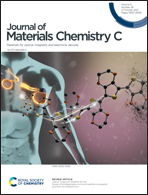Responsive organoboranes with dynamic conformation of octacyclophane-type scaffolds: synthesis, AIE and temperature-dependent dual emissions†
Abstract
In the field of synthetic organic materials, there is still an urgent demand for new smart materials that show great potential in diverse applications. We herein describe a design strategy for the synthesis of luminescent organoboranes (M1, M2 and M3) that feature a central eight-membered octacyclic scaffold with an electron donor (Ar3N) and acceptor (Ar3B) functionalized on both ends. The intramolecular charge transfer (ICT) between triarylamine (Ar3N) and triarylborane (Ar3B) moieties in these structurally highly similar architectures was modulated by simply tuning the electronic structures of octacyclophane-type spacers. M1, M2 and M3 show unusual dual emissions with local excited (LE) and CT characters strongly sensitive to air and temperature. Interestingly, a dynamic conformation switching of the bent octacyclophane was observed in response to thermal stimuli, and the excited-state dynamics were investigated by transient absorption spectra. These organoboranes show thermally responsive luminescence with a distinct hypsochromic shift in the relatively long-lived charge transfer emissions at elevated temperature. Meanwhile, AIE activity of M1 and M2 was demonstrated with highly enhanced emissions in aggregated states. The present findings could provide an important guidance for multifunctional molecular design of responsive materials based on conformationally dynamic building blocks.



 Please wait while we load your content...
Please wait while we load your content...